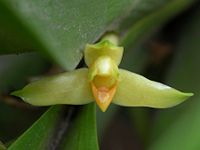Heterotaxis
| Heterotaxis | ||||||||||||||||||||
|---|---|---|---|---|---|---|---|---|---|---|---|---|---|---|---|---|---|---|---|---|
 Heterotaxis sessilis
| ||||||||||||||||||||
| Scientific classification | ||||||||||||||||||||
| ||||||||||||||||||||
| Type species | ||||||||||||||||||||
| Heterotaxis crassifolia Lindl. 1826 | ||||||||||||||||||||
| Species | ||||||||||||||||||||
| ||||||||||||||||||||
| Synonym | ||||||||||||||||||||
Heterotaxis is a genus of orchids formed by a group of circa fourteen neotropical species which previously were considered part of genus Maxillaria. They are strong epiphytic plants with shiny dark green leaves which make a showy display making a very good first impression but end disappointing because of their small flowers, usually yellow, which, because of their short inflorescences, hide between the foliage and can hardly be seen. Although the species that belong to this genus are easy to identify, because they vary a lot and are much similar to each other, to diferentiate them is hard, with very few exceptions.
Distribution
The range of distribution of Heretotaxis is wide, particularly because of the type species, H. sessilis, which can be found from South Florida, Caribbean and Mexico, spread through all Central America countries to tropical America, reaching Bolivia and South Brazil.
All species are mostly epiphytic, despite some hardly ever can be seen living as litophytes on shady and humid cliffs. The species of Heterotaxis hardly ever are found living under full sunlight, being more common under the shelter and shade of trees. They are strong plants that can adapt to diferent environment conditions, since very wet forests of Florida and Amazon, to cloud mountain forests in the Andes and along Serra do Mar mountains in Brazil, and even in dry jungles of highlands of Central Brazil. Some species, like Heterotaxis equitans can be found also living at the edges of the jungles were the get more light than most of other species of this genus.
Description
Heterotaxis are comparatively large and robust plants, usually of sympodial growth, with unifoliate lateraly compressed pseudobulbs, protected by several foliar stealths of almost always glossy foliage; or they can also lack pseudobulbs and have distical leaves, then growing simulating monopodial growth. All species have small thick flowers, which frequently do not open interely, ordinaryly yellowish, but also orange or white, sometimes with purple-bluish, lilac or brown-red spots. A thickening on the center of the lip is also common, sometimes it is covered by waxy trichomes that atract pollinators. Their column is very short. As all species once subordinated to Maxillaria the inflorescences are lateral and bear just one flower, and here are long, short or very short, in small numbers, ordinarily blooming more than once a year.